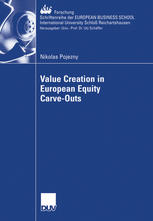

Most ebook files are in PDF format, so you can easily read them using various software such as Foxit Reader or directly on the Google Chrome browser.
Some ebook files are released by publishers in other formats such as .awz, .mobi, .epub, .fb2, etc. You may need to install specific software to read these formats on mobile/PC, such as Calibre.
Please read the tutorial at this link: https://ebookbell.com/faq
We offer FREE conversion to the popular formats you request; however, this may take some time. Therefore, right after payment, please email us, and we will try to provide the service as quickly as possible.
For some exceptional file formats or broken links (if any), please refrain from opening any disputes. Instead, email us first, and we will try to assist within a maximum of 6 hours.
EbookBell Team

0.0
0 reviewsThe total volume of equity carve-outs (i.e. IPOs of subsidiary firms) in Europe over the last 20 years amounts to approx. € 90 billion. Carve-outs thus account for almost 20% of the total IPO volume. Companies use them for a variety of reasons aimed at increasing shareholder value. Nevertheless, not all carve-outs actually do create value.
Employing the most comprehensive sample of European carve-outs to date, Nikolas Pojezny analyzes the performance of carve-outs along various dimensions: Both the reaction of parent firms to the announcement of a carve-out as well as share price and operating performance in a multi-year window around the event are examined in detail. While the announcement of carve-outs on average causes positive share price reactions for parent firms, long-term performance is mixed: Evidence for both earnings management and market timing is found, with negative implications for long-term performance. The potential for value creation increases in the relative discrepancy level between internal and external capital markets. The second event decision seems mainly driven by the valuation level of the subsidiary, industry association, initial stake sold, and development state of external capital markets.